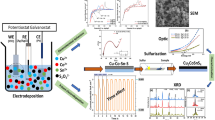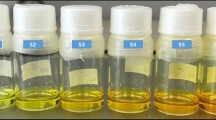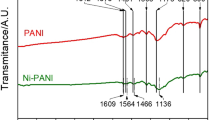Abstract
In the present investigation, polycrystalline semiconductor Cd–Se–Te films have been electrodeposited at room temperature on conducting glass substrates using cyclic voltammetric technique under controlled periodic scans. The successive anodic and cathodic scans were recorded within the potential range, from 0 to −1.0 V, and over the range of periodic cycles, from 250 to 2,000, in an acidic bath containing respective reducible precursor ions like Cd2+, Se4+, Te4+, and 1 vol.% Triton X-100 as the surface-active reagent. Thin composite films were produced having variable thickness and composition and grain size of the order of 80–100 nm. The film properties were determined by focused ion beam analysis, energy dispersive analysis of x-rays, x-ray diffraction studies, atomic force microscopy, and scanning electron microscopy. Thickness of the semiconductor films was found to increase linearly with the number of voltammetric cycles. Band gap energies of the films as derived from the reflectance spectra were found to lie between 1.4 and 1.7 eV. The composite films of the Cd–Se–Te ternary system when electrochemically characterized in aqueous polysulfide solution exhibited n-type semiconducting properties and photoconversion efficiency more than 0.4%.














Similar content being viewed by others
References
Bard AJ, Wrighton MS (1977) J Electrochem Soc 124:1706
Bouroushian M, Charoud-Got J, Loizos Z, Spyrellis N, Maurin G (2001) Thin Solid Films 381:39 (and relevant references therein)
Bhattacharya C, Datta J (2005) Mater Chem Phys 89:170 (and relevant references therein)
Datta J, Bhattacharya C, Bandyopadhyay S (2004) In: Proceedings of the international conference on nanomaterials: synthesis, characterization and application, 4–6 Nov, Kolkata, Tata. McGraw-Hill, New Delhi, pp 426–431
Datta J, Bhattacharya C, Bandyopadhyay S (2005) Appl Surf Sci (in press). DOI: 10.1016/j.apsusc.2005.09.006 (available online; and relevant references therein)
Benamar E, Rami M, Fahoume M, Chraibi F, Ennaoui A (2000) M J Condens Mater 3:71
Das VD, Damodara L (1998) Mater Chem Phys 56:116 (and relevant references therein)
Patil VB, Shahane GS, Deshmukh LP (2003) Mater Chem Phys 80:625 (and relevant references therein)
Murali KR, Subramanian V, Srinivasan K (1999) J Mater Sci 34:3417
Shen CM, Zhang XG, Li HL (2005) Appl Surf Sci 240:34
Roy UN, Babalola OS, Cui Y, Groza M, Mounts T, Zavalin A, Morgan S, Burger A (2004) J Cryst Growth 265:453
Premaratne K, Akuranthilaka SN, Dharmadasa IM, Samantilleka AP (2004) Renew Energy 29:549
Velumani S, Mathew X, Sebastian PJ (2003) Sol Energy Mater Sol Cells 76:359
Matsumura N, Sakamoto T, Saraie J (2003) J Cryst Growth 251:602
Pena DJ, Mbindyo JKN, Carado AJ, Mallouk TE, Keating CD, Razavi B, Mayer TS (2002) J Phys Chem 106:7458
Kressain AM, Doan VV, Klein JD, Sailor MJ (1991) Chem Mater 3:1015
Bouroushian M, Kosanovic T (2005) J Solid State Electrochem (in press). DOI: 10.1007/s10008-005-0670-xDOI: 10.1007/s10008-005-0670-x
Bouroushian M, Kosanovic T, Spyrellis N (2005) J Solid State Electrochem 9:55
Cachet H, Cortes R, Froment M, Maurin G (1997) J Solid State Electrochem 1:100
Datta J, Bhattacharya C, Bandyopadhyay S (2005) Bull Mater Sci 28:253
Memming R (2000) Semiconductor Electrochemistry. Wiley, Canada
Lide DR (1998) Handbook of chemistry and physics, 79th edn. CRC, Boca Raton, pp 8.22–8.25
JCPDS file for CdSe: 08-0459
JCPDS file for CdSe: 19-0191
JCPDS file for CdTe: 19-0193
JCPDS file for CdTe: 15-0770
JCPDS file for Se: 42-1425
JCPDS file for Te: 08-0459
JCPDS file for CdSe0.6Te0.4: 41-1325
JCPDS file for CdSe0.1Te0.9: 41-1324
Jadhav US, Kale SS, Lokhande CD (2001) Mater Chem Phys 69:125
Cruz J, Garcia-choa E, Castro M (2003) J Electrochem Soc 150:B26
Acknowledgements
The authors gratefully acknowledge the University Grants Commission, Government of India, for financial support. The authors are also thankful to Dr. S. Bandyopadhyay of the School of Materials Science and Engineering, University of New South Wales, Sydney, Australia, for providing instrumental facilities (SEM, AFM, FIB).
Author information
Authors and Affiliations
Corresponding author
Rights and permissions
About this article
Cite this article
Bhattacharya, C., Datta, J. Synthesis of nanostructured Cd–Se–Te films through periodic voltammetry for photoelectrochemical applications. J Solid State Electrochem 11, 215–222 (2007). https://doi.org/10.1007/s10008-005-0091-x
Received:
Revised:
Accepted:
Published:
Issue Date:
DOI: https://doi.org/10.1007/s10008-005-0091-x




